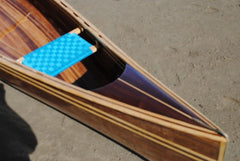Building A 3D Printed CNC to Build My Canoe, by Christian Delbaere

In this guest post by Christian Delbaere, a canoe builder decides to build his own CNC machine using mostly 3D-printed parts in order to precision cut his station molds.
When I started planning out my canoe build, I thought a lot about how I would fabricate the station molds. Should I use try my luck at cutting them out by hand using my bandsaw, or should I get a CNC to do it? I had been thinking about adding a CNC to my shop for several years now, but there were a few things in the way before I could get one. I always thought of them as expensive machines, and a big CNC would take up a great deal of floor space in my garage shop.
When I set up a woodworking shop in my three-car garage, I carefully planned out the layout and dust collection system. In the summer, I can use the whole garage for my workshop. Winters in Ottawa are harsh, and we get a lot of snow, so I wanted my equipment to be fully mobile. When the snow starts to fall, I can neatly tuck everything on one side of the garage and park the cars inside. Since I had everything already optimized, adding a big heavy CNC table to the shop was not workable.
Recently, I found a design online for a small but portable CNC called the MPCNC Lowride2 from v1engineering.com. The MP stands for “Mostly Printed,” and that means that most of the parts can be printed on a 3D printer, making it very affordable. The Lowrider2 uses roller skate wheels and can be mounted on a table or even a sheet of good quality plywood. This was a perfect fit for me. I decided that I would use a sheet of 18mm Baltic birch on my workbench. The setup would be easy to take apart when it was time to pack up the shop for the winter.
I started printing out the parts for the Lowrider2 on my 3D printer and I ordered the hardware kit from the V1 Engineering online store. It took about 2 weeks for the kit to arrive from California. This was perfect since it gave me time to print out the plastic components and source the stainless-steel tubing from a local metal supplier. This image shows all the parts. Don’t forget the safety glasses and bubble tea!

Assembling, wiring and calibrating the machine took about a month. I booked some time off work and my three sons and daughter helped me with the build. It was a great little project for spending time with the kids!
Now I could start cutting the station molds. Using computer software, I sketched hand-drawn versions based on the plans that I ordered from Bear Mountain Boats. This was OK, but I realized from some test cuts, that this was not accurate enough to the originals for my liking. I reached out to Joan Barrett and Steve Killing, and they graciously provided me with the original DXF files. I started cutting the forms out with my little CNC. I would do one or two whenever I had a bit of free time.

Over a few weeks I cut all the forms out of 12mm Baltic birch plywood. I was careful with my X, Y and Z zero positions and workpiece hold-downs. Everything turned out beautifully and matched the original blueprints – aside from the one time I needed to redo a station mold after the router bit came loose in the collet (oops!).


It was very satisfying to install the molds on the strongback and see how well they turned out! They were very symmetric and defect-free, and it made the assembly exceptionally smooth.
When I was in my teenage years, I did a lot of canoeing in Saskatchewan with my Boy Scout troop, and I have always wanted to build my own canoe. Now, I live within walking distance of the river in Ottawa, and I dream of taking the canoe that my family and I are building down to the dock for a trip down the Rideau.
There is really something special about using a canoe built by hand, and it is fantastic that Ted and Joan have made this project so accessible with Canoecraft and the build kits. I also want to thank Ryan from V1 Engineering for making the MPCNC available to anyone who wants to build one. Putting these two projects together has been fun and challenging for me and my family!

